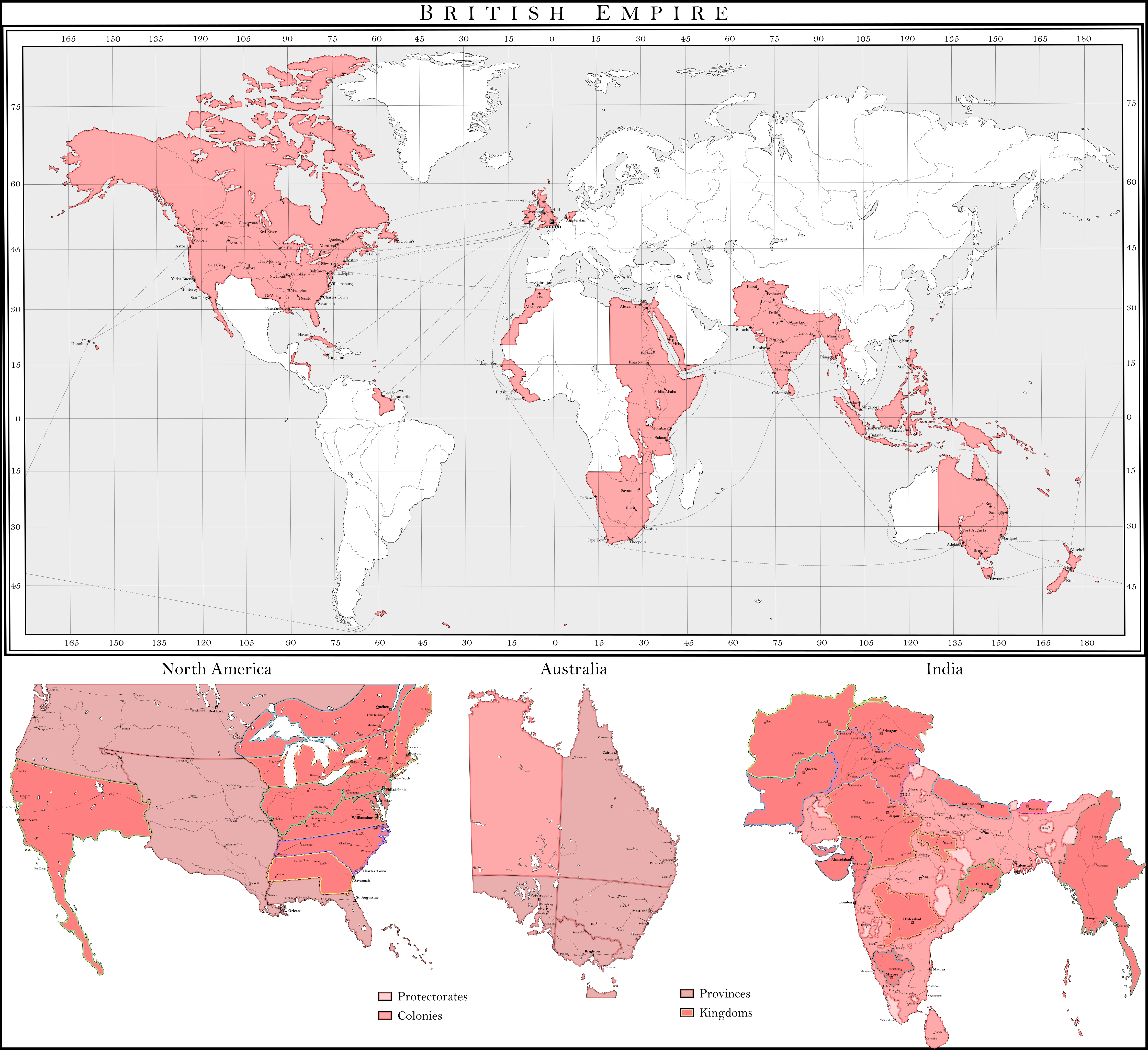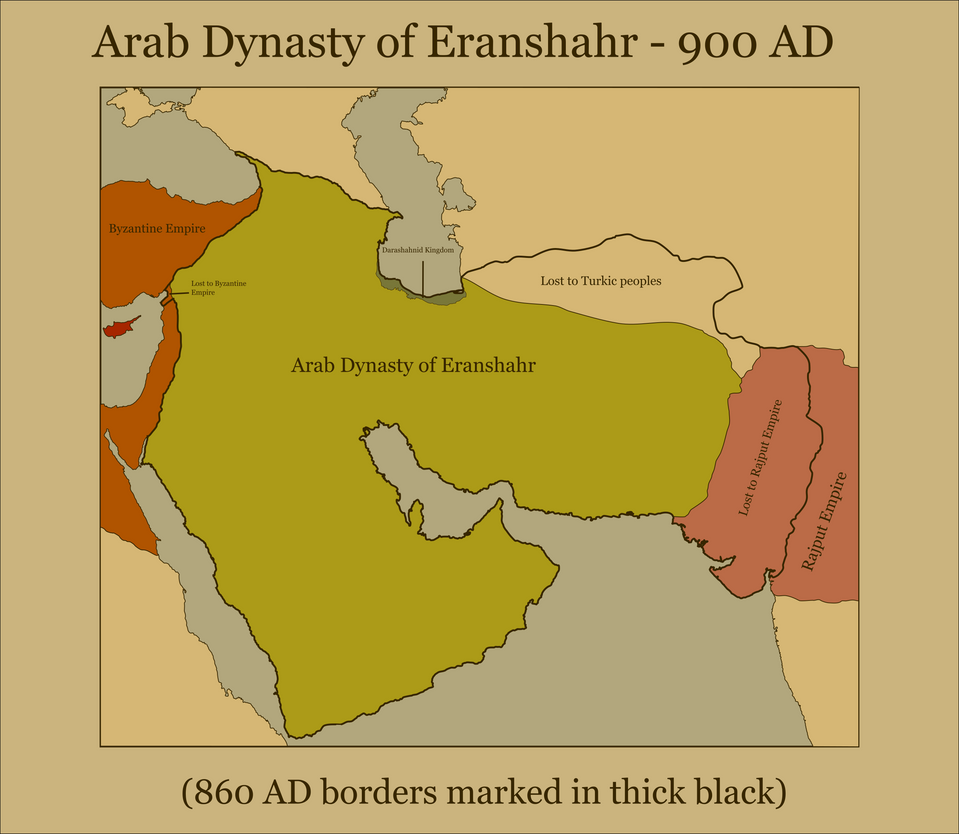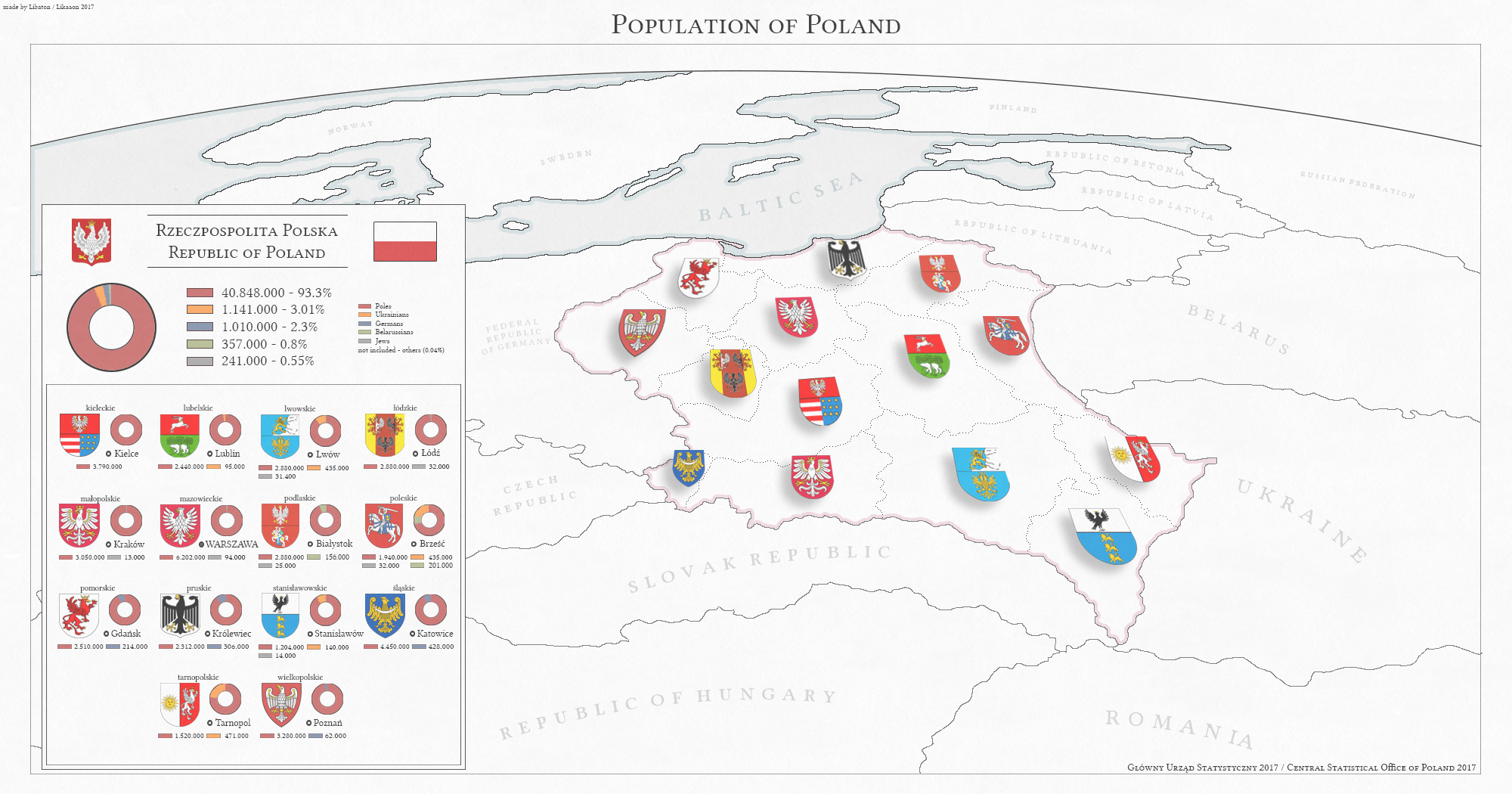Zek Sora:
This map is from the world of
The Century, a world-building project of mine, in the year 1890. Here’s a quick reminder of the structure of the British Empire ITTL in the 1830s from
The Kingdoms of North America:
The Great Convention of 1829-30 came at a very difficult time for the British Empire, but then again it was because the Empire was having difficulties that the Convention was necessary. After many disastrous events, one thing became plain for anyone to see: the Empire was massively, disgustingly, overstretched.
The build up to the Great Convention began with the
Cape Wars of 1802-1809, an total disaster for all parties involved. Despite the fact that neither of the rebelling factions actually managed to capture anything and were generally characterized by gross incompetence and panicked disorganization, it still took British forces seven years to regain control of the entire Cape, a worrying sign.
The next major event worrying away at Parliament were the Western Revolts. The Revolts were not exactly wars, closer to a prolonged period of intense unrest in the less-settled west of the American colonies. The King had banned settlement beyond a certain line, but his proclamations were mostly ignored by American colonists hungry for all the land they could get. Unfortunately, this meant they had to set up effectively independent governments, which aren’t exactly taxable. Quite a few Royal Governors eventually got tired of tax revenues slipping out of their fingers, and began clamping down in the west, establishing their own authority and formalizing the governments there. Of course, there was the small problem that the colonists weren’t supposed to be there in the first place. Both the King and Parliament told the colonial governments in no uncertain terms to stop formalizing western settlement. The colonial governments acknowledged this and continued to do it anyway. The central British government was completely unable to do anything, with tensions in Europe holding its attention.
Then, of course, came the War, lasting for nearly eight years and leaving Britain in possession of all the former Dutch colonies across the globe, as well as several other spoils of war including effective control over most of the Indian subcontinent. Needless to say, this was a lot to handle for anyone. Thus, while at first glance, the British Empire seemed to be at its highest peak, it was in fact an overstretched house of cards ready to collapse at the slightest provocation.
Most everyone in positions of power in Britain saw this, and realized that if the Empire was to maintain its power, something would have to be done. Thus, the Convention was called to determine the future course of Britain all over the globe. What finally came out of it, after a drafting and ratification process taking over a year, was a complete restructuring of the British Empire: the Charter.
The Empire would be divided into several categories of state:
- The Colonies would be ruled in much the same way as before, with an increased role for Companies under Crown charter like the East India Company being the only significant change.
- The Provinces would be given some measure of self-government; on the local level mayors and representatives would be elected, and Provincial Assemblies existed in an advisory capacity. However, the Royal Governor appointed by HM would have final say on most matters of importance. The various provinces would have their own militias, but any standing armies would be a part of the British military structure.
- The Kingdoms would be effectively independent, ruled in Personal Union by HM, free to run their own domestic and some of their foreign policy. They were so independent they were allowed to write their own Charters or Constitutions, if they so pleased (and most of them did). On military matters, they were allowed to keep their own standing armies and navies, but they still had to co-operate on the broader strokes of foreign policy, and were a fully integrated part of the Empire’s economic sphere.
Though the first Kingdom created would be that of the Cape, the vast majority of the Kingdoms would be in North America, hammered out of the former Colonies during the Great Convention. They were, of course, fully allowed to settle their western lands (if they had any) and determine their own form of government. Despite this, Pennsylvania was the only Kingdom that really adopted a radical system, having a unicameral parliament with no upper house and no voting requirements. Slavery is still prevalent in many of the southern Kingdoms, though the slave trade has long been abolished and the land is beginning to grow tired in many states. The current hope of HM’s Government is that it may die out on its own in the Kingdoms soon, but no one can be certain.
And now, some of the events in the intervening years:
After a few fixes here and there, the relation of the British Parliament to the various Provinces and Kingdoms was decided. An Imperial Parliament was created, where each Province (as well as Britain proper, which itself effectively became a set of Provinces under the Charter) would send voting members, and the Kingdoms would send “advisory” ones, who effectively acted as lobbyists for their homelands. The Imperial Parliament would decide matters of foreign policy and inter-Provincial/Colonial trade, somewhat akin to the early OTL American federal government. The Great Convention allowed the British Empire to largely overcome its massive overextension by devolving many powers to local authorities, but the Empire proper still had its hands full enough that it was mostly unable to expand for a few decades.
This inability to expand, however, did not extend to the Empire’s various Provinces and Kingdoms. The Hudson’s Bay Company would continue to expand across the western plains, their traders and settlers often illegally entering French Louisiana. Their illegal entries, however, paled in comparison to those from the North American Kingdoms. By the early 1840s, the largest group (with a nearly two-thirds majority of the population) in French Louisiana was settlers from the various Kingdoms. After numerous small-scale and a few not-so-small-scale Anglo settler revolts, the French king recognized the untenability of the situation and elected to sell the relatively unprofitable colony to the British, who created a Province of Louisiana (thanks to the mixing of the Kingdoms’ settlers effectively eliminating their various local identities) after carving off the parts of it above the 50th parallel and adding it to the territory of the Hudson’s Bay Company, which was shortly before merged with its rival, the North West Company, into the Province of Rupertia.
Another region that had been subject to heavy Anglo settlement in the 1840s and 50s was the New Spanish provinces of Alta and Baja California, thanks to the discovery of gold in the region. During the Spanish Rising and subsequent civil war that had followed the Great War, New Spain had become effectively self-governing, with the Viceroy of New Spain taking
de facto power while still remaining
de jure subordinate to the Spanish king. After the civil war, however, with the only remaining Spanish king being the infant pretender in Peru, it was clear a choice had to be made between monarchy and republic. The Viceroy, of course, opted for the former. Much of the populace of New Spain…disagreed. In the subsequent civil conflict, the Californias broke off and formed the Anglo-dominated Republic of California. Unfortunately for the young Republic, the conflict in New Spain was brief, and the winners soon wanted the two breakaway provinces back. So, to preserve their independence, the Californians technically gave it up, becoming the Kingdom of the Californias under the British monarch, with the same privileges and responsibilities as any other Kingdom in North America. This, of course, angered the New Spanish to no end, and there remains animosity between the two powers.
The next great crisis that faced the British Empire came from the jewel at the center of its crown—India. In the Great Revolt of the 1850s, populations across British India rose in rebellion against local and general colonial mismanagement and oppression. While eventually the revolt was put down, it required massive amounts of blood and money to do so, and like OTL, the British government realized that a new approach was needed in India. Unlike OTL, however, the East India Company was not removed, merely reformed. (It was deemed unwise to dissolve it, thanks to its relatively effective governance of possessions in the East Indies, and the sheer cost and effort it would require to set up new government across all of its possessions.) The Empire also did something it had never done before: created non-white Kingdoms. However, these Kingdoms differed distinctly in structure from the ones in North America and the Cape. First of all, most of them were federal in nature, as well as mostly being absolute monarchies with little to no room for democracy. Effectively, what they did was give independence to local princes to run their own affairs, as long as the money kept flowing into Company coffers and the Sepoys kept coming into the Company’s army.
The final major event before 1890 was the Division of Africa. With the rise of new technologies that allowed for the colonization of the previously untamable Africa, representatives of the various colonial powers (the Empire, France, Brazil-Portugal, and to a lesser extent Scandinavia, Sicily, and the various German states) convened in Amsterdam. When the delegates left, they had hammered out a plan for the division of Africa. The Empire, of course, took the lion’s share as not just the premier world power, but the one with the most African territory already held. Construction immediately began on the much-hyped Cape-to-Cairo railway, and was complete within just a few years.
Now, the Empire spans the world much as the Cape-Cairo railway spans Africa. The King-Emperor’s word may not be law in its every corner, but so long as the people there take tea, sing
God Save the King, and send (at least observatory) members to Parliament, nobody really minds too much.
 Behold, the Habsburg World-Empire! The PoD is that Charles V managed to also inherit the throne of France, and cement Habsburg domination of Europe and the Americas. With this power base, the Habsburgs took their tactic of marrying into local elites and sticking an oar into other folks' disputes global, aligning with Kongo, Dai Viet, Persia, and a Christian Daimyo in Japan, to name a few. For those states they couldn't marry into, brute force sufficed: though only in the last century has the World-Empire achieved domination of China - a Habsburg brother was finally placed on the throne, inaugurating the Ximing (Western Ming) dynasty after a brutal 15-year war, 1860-1875. Inland Africa was also difficult to control, and rebellion still simmers there and in the rump Sultanate of Rum, as well as in India. But in A.D. 1900, Charles XIII is the undisputed ruler of the world, in the twelfth year of his reign. Technology is about 50-75 years behind our world in most fields, and industrialization for nonmilitary purposes proceeds slowly. Since about 1700, the Habsburgs have mostly only provided lip service to the Church's goal of crushing the Protestant heresy and converting the heathens of the world, though missionary efforts continue and it's difficult to rise to high office if one is not a Catholic.
Behold, the Habsburg World-Empire! The PoD is that Charles V managed to also inherit the throne of France, and cement Habsburg domination of Europe and the Americas. With this power base, the Habsburgs took their tactic of marrying into local elites and sticking an oar into other folks' disputes global, aligning with Kongo, Dai Viet, Persia, and a Christian Daimyo in Japan, to name a few. For those states they couldn't marry into, brute force sufficed: though only in the last century has the World-Empire achieved domination of China - a Habsburg brother was finally placed on the throne, inaugurating the Ximing (Western Ming) dynasty after a brutal 15-year war, 1860-1875. Inland Africa was also difficult to control, and rebellion still simmers there and in the rump Sultanate of Rum, as well as in India. But in A.D. 1900, Charles XIII is the undisputed ruler of the world, in the twelfth year of his reign. Technology is about 50-75 years behind our world in most fields, and industrialization for nonmilitary purposes proceeds slowly. Since about 1700, the Habsburgs have mostly only provided lip service to the Church's goal of crushing the Protestant heresy and converting the heathens of the world, though missionary efforts continue and it's difficult to rise to high office if one is not a Catholic.






